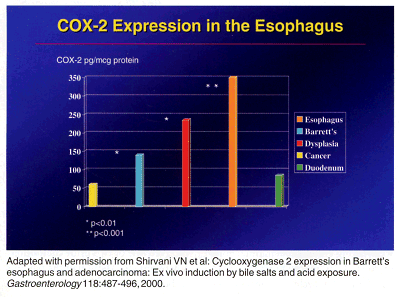Translational Research, Early Clinical Trials Support Xeloda/RT in GI Cancers
ORLANDO-Capecitabine (Xeloda) might one day replace infusional fluorouracil (5-FU) as a radiosensitizing platform in the chemoradiation of advanced gastrointestinal malignancies, according to Tyvin A. Rich, MD, professor of radiation oncology, University of Virginia Health Sciences Center, Charlottesville. The oral fluoropyrimidine simplifies chemoradiation, is well tolerated, and is highly appealing to patients and physicians alike, he said.
ORLANDOCapecitabine (Xeloda) might one day replace infusional fluorouracil (5-FU) as a radiosensitizing platform in the chemoradiation of advanced gastrointestinal malignancies, according to Tyvin A. Rich, MD, professor of radiation oncology, University of Virginia Health Sciences Center, Charlottesville. The oral fluoropyrimidine simplifies chemoradiation, is well tolerated, and is highly appealing to patients and physicians alike, he said.
Speaking at an industry-sponsored symposium held in conjunction with the ASCO meeting, Dr. Rich reviewed results with 5-FU and radiation therapy (generally in the range of 45 to 55 Gy) in esophageal, gastric, biliary, pancreatic, and rectal cancers.
With a 5-FU/radiation therapy combination, Dr. Rich said, approximately 25% of patients with esophageal cancer now achieve a 5- to 10-year cure. A phase III trial of bolus 5-FU/leucovorin and radiation therapy in gastric cancer, which was reported by the Southwest Oncology Group last year, achieved cures in about 50% of patients.
Dr. Rich’s group is now taking the 5-FU/radiation therapy data and looking at new agents and new combinations, including radiation therapy plus capecitabine.
Capecitabine is a logical choice to pair with radiation therapy for several reasons, he said. The drug itself is active, it is well tolerated with radiation therapy, and it has a three-step metabolism that involves thymidine phosphorylase, which ultimately leads to concentration of 5-FU in the tumor. Moreover, preclinical data indicate that radiation therapy upregulates thymidine phosphorylase.
"So we may be able to target the cancer and turn on something that makes the drug a little bit more effective," Dr. Rich said. "We haven’t proved this in a clinical setting, and I think it’s going to be a long time before we’ll have those kind of data, but translational research would lead us to believe that this may be the case."
A phase I German study of capecitabine plus radiation in patients with rectal cancer (Dunst J et al: Proc Am Assoc Clin Oncol 2001, abstract 592) concluded that 825 mg/m² of capecitabine bid on days 1 to 7 each week along with 50 to 59 Gy of radiation therapy was well tolerated.
Dr. Rich’s group is planning a phase I trial of fixed-dose capecitabine and radiation therapy plus escalating
doses of the COX-2 inhibitor celecoxib (Celebrex) in patients with locally advanced esophageal or pancreatic cancers. The investigators plan to give a total of 2,000 mg/m² of capecitabine a day, divided as 500 mg/m² in the morning and 1,500 mg/m² in the evening.
By "temporal targeting" of the dose, they hope to take advantage of circadian variations in dipyrimidine dehydrogenase (DPD). "Levels of DPD are higher in the evening," Dr. Rich said. "We think that might be another leveraging point to getting less toxicity without sacrificing tumor effect."
The planned dose escalation for celecoxib is 100, 200, 300, and 400 mg twice a day. Radiation will be delivered as 50.4 Gy to large fields.
The rationale for adding a COX-2 inhibitor is based on several qualities of agents that inhibit COX-1 and COX-2 enzymes. Aspirin and nonsteroidal anti-inflammatory drugs (NSAIDs) inhibit COX-1 and 2, and reduce the risk of some cancers; COX-2 levels are elevated in malignant tumors; COX-2 affects proliferation, angiogenesis, immune response, and apoptosis; and selective COX-2 inhibition has been shown to reduce polyp formation in familial adenomatous polyposis.
Moreover, Dr. Rich noted that in the esophagus, there is a clear progression of increasing COX-2 expression beginning with the normal esophagus and progressing through Barrett’s esophagus, dysplasia, and neoplasia (see figure below). Studies are now under way to determine whether COX-2 inhibition can interfere with the progression of Barrett’s esophagus.

Why add a COX-2 inhibitor to chemoradiation? Preclinical work suggests that the triple combination leads to greater cytotoxicity. In addition, work conducted by the experimental radiotherapy group at M.D. Anderson Cancer Center has shown delays in tumor regrowth and an effect on tumor cure in mice. The combination has shown very little or no toxicity in jejunal crypt assays.
Dr. Rich’s group has already accumulated some data on esophageal cancer patients who were taking celecoxib for other indications. One patient with a very large distal esophageal cancer and nodal disease at the celiac axis, for example, had a complete response on the triple combination. Another treated patient with a T3 esophageal cancer has no gastrointestinal symptoms after 1 year, and the CT scan remains clear.
"This is a very small experience, very early data," Dr. Rich said. "We’ve treated a total of 16 patients, five preoperatively. Four patients had major regressionstwo had no tumor in either the primary or the nodes, and two had microscopic disease in either the primary or the nodes. This is somewhat encouraging information in this very small pilot trial. And the treatment seems to be well tolerated."
Future Trials
Dr. Rich noted that the Radiation Therapy Oncology Group (RTOG) is considering a proposal to substitute capecitabine for infusional 5-FU in combination with either irinotecan (Camptosar) or oxaliplatin (Eloxatin, investigational in the United States) in a phase II trial of preoperative combination chemoradiation for rectal cancer.
The National Surgical Adjuvant Breast and Bowel Project (NSABP) has proposed a study that will evaluate preoperative radiation therapy and chemotherapy with either 5-FU or capecitabine (in a Dunst-type approach) for patients with T3/T4 rectal cancer.
"This will be a ‘gold-standard’ and very important study to do," Dr. Rich said. "But you may see us clinically migrating from infusional 5-FU to capecitabine while this study is being done because it may be 5 to 7 years before we have the proof."
How Supportive Care Methods Can Improve Oncology Outcomes
Experts discussed supportive care and why it should be integrated into standard oncology care.